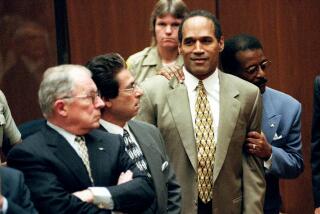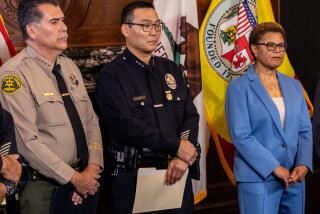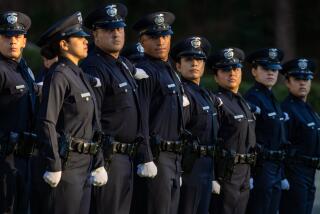Opinion: Patt Morrison asks Charlie Beck: A transcript
Charlie Beck is chief of the LAPD, entering his seventh year as chief, and it’s always a pleasure to have you across from me at a microphone at a table.
Well, thank you, Patt.
A big subject on many people’s minds since the Dec. 2 attacks in San Bernardino is terrorism.
The reality is that our enemies have shifted their efforts and we have to be aware of that.
They have moved to a recruiting posture where they try to radicalize individuals through the Internet and inspire them to follow the tenets of ISIS and reach out, reach out and cause terror. And that’s what happened or appears to have happened in San Bernardino.
What changes does your department have to look at now that Michael Downing, who’s in charge of antiterrorism efforts for the department, says that “iconic symbolic targets are not now as high on terrorists’ priority lists as killing high numbers of people.” Are you thinking of malls or festivals? The long beach aquarium was the subject of one exercise.
Well, we do try to be more agile, to have more, smaller sets of resources available and put a high profile in places that we think may be likely targets given the new paradigm.
Is it all about numbers or is there something else strategically that you can do?
It takes numbers to do this because you have to go to multiple sites, the sites are not as easily predictable, they’re not as static as we would have thought in the past.
It’s not like it’s all about protecting Disney Hall or the Grove or any one place. It’s about having the ability to protect every place and to respond to every place. So you have to have agility, you have to have numbers, you have to have good intelligence, you have to have people that recognize patterns as they pop up, and are able to adapt and respond. We’ve led the nation in that kind of training and will continue to do it.
LAUSD canceled classes on the basis of a threat that was the same as what New York got and decided not to.
Well, it wasn’t exactly the same as what New York got. By the time New York got their threat they were in second period; they couldn’t have canceled their classes if they’d wanted to.
And our former chief, Bill Bratton, now the commissioner in New York, was critical of Los Angeles taking the action it did.
He was. And that’s Bill’s prerogative. I talked to , we’ve communicated and Bill has , he’s a great leader, a great mentor of mine, you know, I think given his stature in the in law enforcement, he has the right to his opinion.
You were evidently giving your advice to the LAUSD and the mayor didn’t say what that advice was. Can you?
No, I’ve already said I won’t say what that advice was and if I gave you advice I wouldn’t tell anybody else either. People that have to make tough decisions get advice from multiple sources, and they should get the advice from the best sources possible, and I think that [LAUSD Superintendent] Ray Cortines did that. And then he has to make the decision.
He is the one responsible for the decision, he is the one that has to live with it. He is the one that will be judged by it, and I think people need to understand that and to second guess a rational decision. It certainly wasn’t one out of the realm of response.
I always put it this way, if you were taking your young person to school and you knew that the threat had come in about a mass shooting in the school district, would you drop your kid off, or would you take him home? I’d take mine home.
The topic that comes to mind is the topic of crime rates, that they have gone up from one year to the next, violent crime up almost 20%, property crime up about 10%. We’ve had a very long period of very low crime rates and this came as something of a surprise.
I think that a couple of things have to get recognized: that crime is a function of a lot of things in society, some of them within my control, some of them external to my control. I think when we look at crime this year in retrospect we’ll see crime across California increase not just in Los Angeles.
Certainly crime in L.A. County and our neighboring cities is increasing and all my indications are that crime in all the major cities in California have increased, and this is after, as you say, historic lows.
But I think is -- , one thing I want to emphasize is context. We are still in the lowest crime rate era of my lifetime. When you look at crime per capita in Los Angeles, it is still lower per capita in the city of Los Angeles than it was in the year that I was born, 1953.
And homicides, because they’re a number that are easy for folks to grasp rather than 100,000 or so “part one crimes”; 283 homicides in the city of Los Angeles this year [meaning 2015]. That’s 200 less than Chicago had, which is a city of a million and a half less people than Los Angeles. It is on track with our five-year average and if you exclude the preceding five years, the years I’ve been chief basically, you have to go back to 1967 to find a year when homicides were lower. And that’s not per capita, that’s the number of homicides.
So, you know, I’m not trying to downplay the increase because I own it. It’s important, it is something that we need to exhaustively examine and have exhaustively examined and see where we can make adjustments and get back on track to lowering crime every year.
When we look at property crime this year, the bulk of our increase is in vehicle-related crime. We’ve had a downtrend in vehicle theft for the past six years, and this is the first year they’ve ticked back up. And we’ve also had an increase in car break-ins, and these are exactly the type of crime that is characteristic to the type of folks who are not spending time in jail due to Prop. 47 [the 2014 ballot measure that reduced many nonviolent, non-serious crimes to misdemeanors].
And I’m not going to -- , I can’t draw a direct-line correlation but I can take my inference and by the example of other cities in California that are affected by 47 and have seen similar increases that this is part of the causation. It’s not all of it, it’s part of it.
I don’t want people to take this that I’m condemning wholesale Prop. 47 because I also think we incarcerate too many people. But if you don’t put them in jail you’ve got to get them help somewhere, you know.
Drug addicts, if left to their addiction, are likely to, are much more likely than the general population to resort to theft and petty crimes and that’s what we’re seeing. So we need an avenue by which we can force people into treatment.
And when you’re talking about addicts, these are folks that desperately need a road map and guidance, that’s what gets them into this circumstance, so if the court can’t provide that or the police can’t provide that, then we are doomed to fail.
We’re looking at a couple of things I think are very promising. We’re doing what we call a pre-arrest diversion. In other words, take somebody into custody for narcotics and you arrange that the charges won’t be filed if they complete a program. Then they avoid the total consequence of having an arrest on their record and they have an incentive for completing a program.
This past year, all we’ve had is the negative aspects of 47 and none of the positives: none of the accelerated treatment, none of the system-wide programs that could make a difference in people’s behavior. So now we are going to demand and are hopeful that those things start occurring.
One of the other numbers that’s come up is the near doubling of police shootings: 23 in 2014, 45 in 2015, a lot of outcry by Black Lives Matter, across the country, certainly not just here, demonstrations at police commission meetings. What to say about the rate of police shootings and to this general new climate of concern and even anger from some quarters?
You know, I mean, it is absolutely true that we’ve had many more police shootings this year than last year, but we are not that far from our five-year average, and we are not even close to the levels of shootings we had in 2011.
So you know these -- , I mean, I don’t want this to be taken out of context. We had 48 shootings last year. That’s a lot of shootings. Every one of them is important to me, every one of them investigated, every one of them is looked at stringently and as painstakingly as is possible.
But given the context of our scope of business, that we make hundreds of thousands of enforcement contacts every year or are engaged in the investigation of a thousand shootings a year, we recover 6,000 handguns a year, we live in a society that a small proportion of folks see violence as the only solution to conflict. That has to be looked at.
So we will as always try to learn from each and every one of these shootings to limit the number of times that officers use deadly force but officers are confronted with deadly force quite often.
Anything to be done in terms of public accountability, transparency, things you might want to change about how you talk to the public about these?
We’re going to have a very in-depth summary and analysis of our shootings that the president of the Police Commission and I will deliver to the media at the end of this month.
We’ve seen a tremendous increase in incidents that are obvious suicide by cop, we’ve seen a huge increase in our contacts with folks that have mental disabilities, that not only combine mental illness but alcohol or drugs, we are seeing some trends that are very difficult for police officers to deal with, when they have split seconds to make a decision.
Policing had a difficult year last year, not just in Los Angeles but maybe even less so in Los Angeles but certainly nationally, and you know this national conversation about policing is something that I am very interested in and involved in at a national level, and I think that oftentimes Angelenos become -- , don’t see the picture of how far their police department has come.
You know, we are certainly not a perfect organization but many of the changes and strategies that are being used for police accountability across the country have been in place in Los Angeles for years.
The president’s executive action to help close gun show loopholes, purchase loopholes – do you think that will help?
Well, you know, yeah, I think it will help. The state of California does pretty much all of that already but our neighboring states do not. I think that limiting the flow of handguns, especially the easy flow of handguns and assault rifles, is an important first step.
But recognize that, you know, there’s over 350 million guns in circulation in this country already, you know. It’s important to realize that there are more than enough guns to last until the end of the earth in this country and we have to do something about addressing that, and I think that is an important piece.
Nationally the way guns go to crime is very different, you know. In Chicago and on the East Coast, guns go to crime through gun stores and straw purchases. In Los Angeles, guns go to crime through burglary, through breaking into cars, stealing guns from houses. Of course this is not an absolute but it is the majority. So we have to look at ways to limit that.
Nobody’s been more exposed to gun violence than me in an urban setting, you know, and I have the difficult task of leading the people in this city who are most likely to be the victims of gun violence, and that’s Los Angeles police officers.
The body camera rollout was slowed by the City Council, which was surprised at how expensive it was going to be. What’s the status of it now?
We’re waiting to do some hearings before council and hopefully we’ll be able to address their concerns. You know, I think that all of the monetary figures that have been given out are five-year figures, you know, and they will save far more money than we invest. I think they are important piece to police accountability, to community confidence, to all of those things and I know that the council thinks that also.
There were objections to the notion that officers will be able to view video before they write up their reports. Why do you think that’s important that they should be able to do that, considering people think one version versus another version is an important part of any investigation?
Well, there are multiple ways by which officers refresh their recollection during an investigation, whether it be note-taking, whether it be tape recordings or video recordings, you know, and I think officers should have the ability to accurately transcribe evidence into an investigation.
Now probably the most controversial question, which is why I saved it to last: Which team should come to Los Angeles -- Raiders, Rams or Chargers?
Well, you know, whatever team comes – and I won’t pick one because that’s not fair -- but I will say this: Whatever team comes here, I think that they have to accept the challenge of helping to reduce youth violence.
You know, football by its nature celebrates violence. It is obviously done in a sporting context, just as in boxing or mixed martial arts but make no mistake: It’s a violent sport. And oftentimes young people, particularly young men, cleave to that, and find role models in the people that participate in that.
And so they need to be the right role models. Whatever team comes here, I want to ask them, and I have asked several of them already, to be part of that conversation, to be part about talking, that violence is not something for the street, that disputes can be solved in means other than by a firearm.
This is the tragedy of Los Angeles. We lose hundreds of young men -- sometimes hundreds, this year probably less than that -- to gun violence over meaningless disputes every year, and that has to stop. And these football teams could be part of that.
The “Patt Morrison Asks” podcast is produced by Patt Morrison and engineered and edited by Todd Levin.
More to Read
A cure for the common opinion
Get thought-provoking perspectives with our weekly newsletter.
You may occasionally receive promotional content from the Los Angeles Times.







